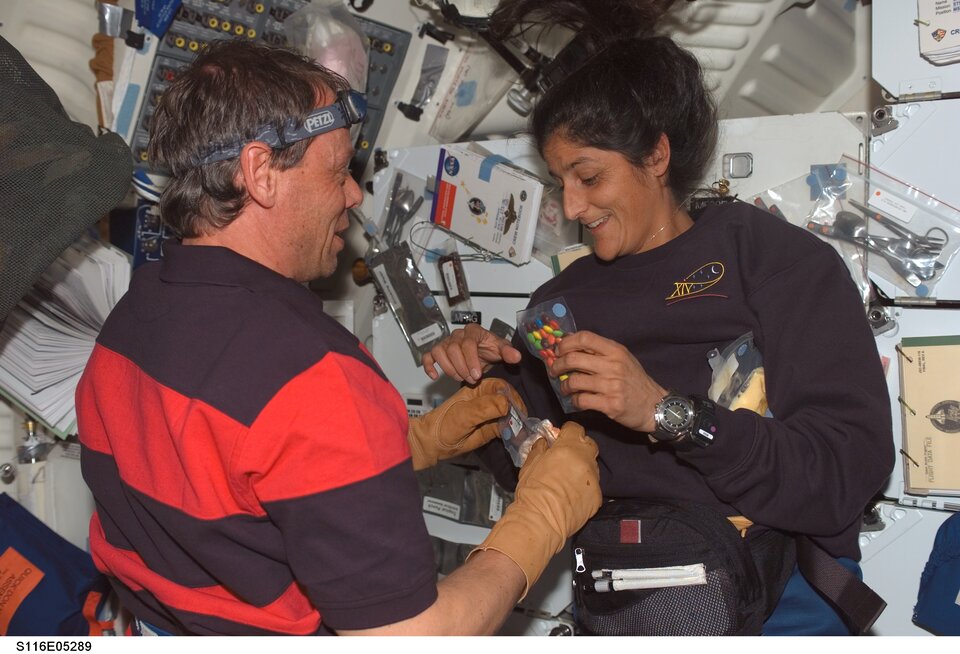To boldly go... where dreams come true
The International Space Station (ISS) is the largest structure humankind has ever built for space purposes. The Station is also the first of many steps, including returning on the Moon, which eventually will lead to Mars, and beyond. What, then, is the role of the ISS in the greater context that is human spaceflight?
"I think the ISS is very important for further space exploration", says the Swedish ESA astronaut Christer Fuglesang. "It is the step we need in order to learn how to live and work in space, how humans react to the weightlessness and the radiation exposure of long duration spaceflights. It is the step we need to be able to get to the Moon, Mars, and beyond."
Christer Fuglesang thinks that the ISS also is important from a political perspective, to gain support for the projects that are necessary to extend human presence in space. "Hopefully Europe will be a part of this."
The weight problem
Something we have to solve before we can send people on trips around the Solar System are the physiological effects of the absence of gravity. Here, the ISS plays a key role. It gives us the only opportunity we have to study how the human body reacts to long periods of weightlessness. Among the problems that arise are the loss of muscle and bone mass. Other problems are a decrease in the red blood cell count, and that the immune system has a tendency to weaken.
Yet another problem astronauts on extended trips will encounter is the radiation of interplanetary space. Even on board ISS, well above the Earth's atmosphere, the astronauts haven't completely left the Earth's protective care. The Station is deep within the Earth's magnetic field and the radiation belts this generates. This way the astronauts on board ISS are protected from most of the radiation. But the Space Station still gives us an opportunity to study how space radiation affects the human body.
As the medical knowledge gathered on board ISS increases, spacecraft engineers will be ever more able to judge what is needed to maintain the health of interplanetary astronauts.
To maintain life

Another area where the ISS can give an invaluable insight is life support systems. On a three year return trip to Mars, or for people to be able to live in a Moon base, it is essential to have a life support system that can work without external input, as a closed system. Some elements maybe can be supplied on site on the Moon or on Mars, but for most of the life support systems operation this will not be possible.
When speaking of life support systems, food, air and water are probably what springs to mind. There are however other things that are difficult – if not impossible – to live without.
"The first astronauts could get by with nappies. They didn't need a toilet on those short missions. But for a trip of half a year, or more, that simply doesn't work," says Mats André, Professor of Space Physics at the Institute for Space Physics in Uppsala. On board the ISS, and on long journeys in the Solar System, everyday life must be able to continue.
New technology
Human spaceflight has an important role also in a broader perspective. "Space is one area that drives cutting edge technology", says Mats André. "For example, you very rarely get a chance to repair something in space. Stuff simply has to work." As an example of space driving technology, he talks about the courses the Institute give in space technology. "Many of our students don't end up doing space related things. But they do get involved with technology at the real cutting edge."
From another point of view the ISS makes it possible to learn techniques and methodologies for constructing structures in the weightlessness of space, and how to work with the help of robotic systems.
Robots are good but people are better
There is also a very ordinary reason why humans should follow where robots have led. "There are things human space missions can accomplish that otherwise is virtually impossible", Mats André explains. "We can do much with relatively inexpensive, unmanned probes. But only gets you so far. To take the next step, you actually have to send a geologist to Mars with a hammer to bang at the rocks. There is no way around it."
Lennart Nordh, Head of Research at the Swedish National Space Board, is of the same opinion. "If we look in a desert on Earth, it's difficult to detect life. We must find the right places and dig to find it. So, if we really want to establish whether there is life on Mars, my guess is we'll have to go there."
Wouldn't it be just a little sad if we didn't find out we have strange cousins in the Martian permafrost, or in hot springs at the bottom of Jupiter moon Europa's ocean, just because we didn't send curious and enterprising people, but were content to send robots.





